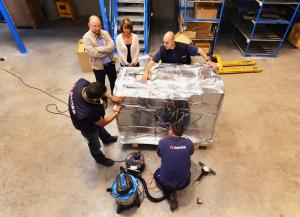Packed for India, then China
9 Jul 2013
-
R.A.
ITER Coil Instrumentation engineer Felix Rodriguez-Mateos and DAHER's Ines Bollini (left) watch as dozens of components are being taped, wrapped into thick heat/humidity insulation aluminium foil and placed into a robust wooden crate.
In a nondescript warehouse some 30 kilometres from the ITER site, instrumentation components destined for the Tokamak's magnet systems are being prepared for a long journey.
Carefully arranged in their cardboard boxes, dozens of components—cables, connectors, sensors, signal conditioners—are being taped, wrapped into thick heat/humidity insulation aluminium foil and placed into a robust wooden crate.
The crate is going to India, where an ITER Organization contractor will install about 20 different types of electronic components into three cubicles and make sure that everything is operational. Once completed and tested, the cubicles will be shipped to ITER China to be used for the tests of prototype current leads, which must be qualified before actual series production begins.
For the components shipped on this occasion, the Magnet Division has relied on the help of CODAC Division engineers who have prepared a cubicle including a sub-system responsible for the investment protection during the tests.
"This place acts like a buffer," explains ITER Coil Instrumentation engineer Felix Rodriguez-Mateos. "This is where we store the instrumentation components that we have developed, or bought off the shelf when industry has developed a solution that we consider satisfactory. The components are verified and reconditioned before being sent to the Domestic Agency in charge of their qualification or integration into prototypes and mockups."
Contrary to the large majority of ITER components that are procured and delivered to the ITER Organization "in-kind" by the Domestic Agencies, the totality of magnet instrumentation (for feeders, coils and structures) is provided by the ITER Organization by way of "fund procurements."
The ITER Organization buys (or develops) the needed components, has them installed by a contractor or directly by the Domestic Agency concerned. It is then the Domestic Agencies' responsibility to validate the assembly procedures in prototypes or mockups prior to entering actual production. (In a later phase, in a lab installed for ITER, the ITER Organization will test assembly procedures for the systems it is responsible for.)
The complex logistics involved in sending the component-packed crates around the world are handled by the DAHER Group as part of their framework contract with the ITER Organization. "We never send anything before every problem, customs-related or other, is solved," says DAHER's Ines Bollini, who is present every time a crate leaves the warehouse. "There can be no improvisation..."
Every other week or so, a crate leaves the warehouse for a foreign destination. Its content is as important for ITER success as the giant components being manufactured throughout the world.


